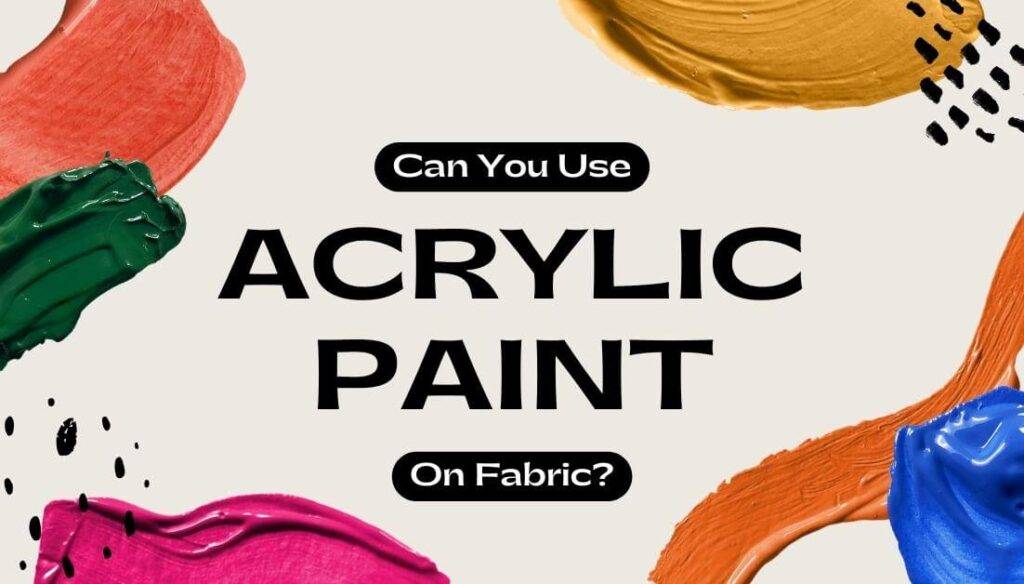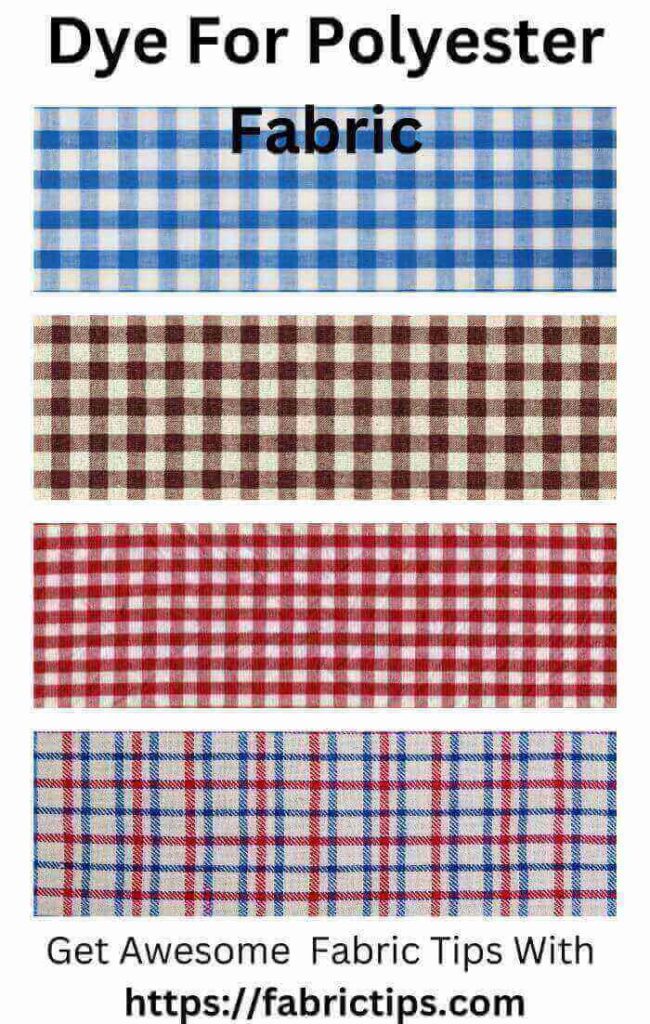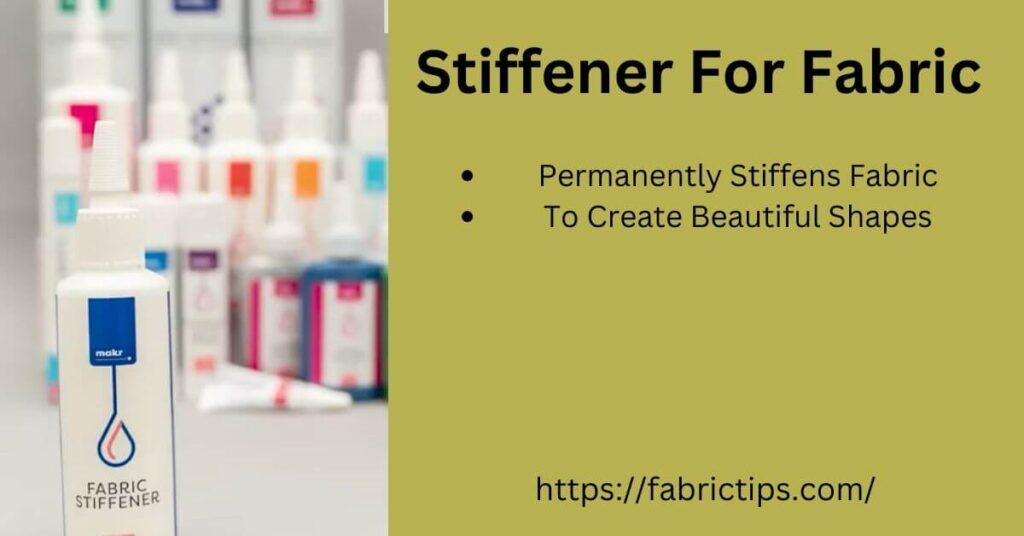Last Updated on December 13, 2025 by Wahid
The worldwide query is “Can You Use Acrylic Paint On Fabric?” YES, you obviously can. It is possible to use acrylic paint on dark fabrics, but you might have to apply a white base coat or use a lighter color to help it stand out. Acrylic paint is also best applied using fabric medium to avoid cracking or peeling over time and to ensure proper adhesion.
Yet, acrylic paint adheres well to synthetic and natural fabrics, it is often used in fabric art. Acrylic paint on fabric can be made permanent by using heat-setting & a sealant. This article explains the difference between fabric paint and acrylic paint. You can find instructions for drawing on fabric with acrylics here. And finally, discover how acrylic paint can be used safely as art, and how to preserve & care for it. Well, let’s begin the journey.
Can You Use Acrylic Paint On Fabric? [Answered Below]
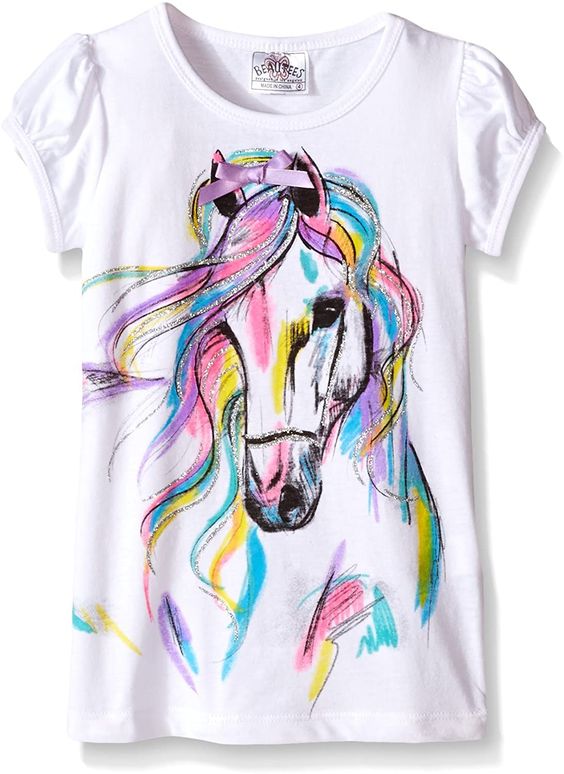
Have you ever wondered, “Can you use acrylic paint on fabric?” In a word, YES, absolutely! Yet, in order to achieve optimal results, preparation is necessary.
Remember, Acrylic paints aren’t suitable for all fabrics, so if you don’t use the right paint & tools, you may damage your fabrics. Our goal here is to give you all the tricks and tips for painting fabric with acrylic paint, as well as how to achieve the best results.
- Acrylic paint on fabric can be used for a wide variety of projects, including stenciled t-shirts and stunning wall tapestries.
- Acrylic paints continue to be a popular choice for textile art due to their ability to adhere to a variety of materials & their versatility.
- This type of paint also has vibrant colors and is very durable, which makes it an excellent choice for clothing art.
- A film of plasticky, water-resistant paint will dry on the fabric by itself. The texture of wearable fabric art needs to be softer and more flexible by using a thinning agent.
- When it comes to blending acrylics, you can create your own colors easily. Because acrylics are water-soluble, you can thin them while wet.
- If you’ve ever walked through the local craft store, then you’re familiar with how affordable acrylic paint can be!
- Honestly, acrylic paints are a great choice for most textile arts. However, if you know how they work, you will be able to make the most of them.
What Is Fabric Paint?
As a start, fabric paint possesses a different composition than acrylic paint. As its name implies, this medium is made up of fabric dye and a binder, which helps it adhere to fabrics better.
Despite being specifically designed for fabrics, most people are unaware that fabric paints are only suitable for natural fibers & not synthetic fibers. Hence, we prefer using acrylic paints when painting fabrics.
The truth is, we don’t care if the surface we are applying is natural or artificial. It’s just time to start painting!
You can use the following brands if you decide to use fabric paint:
- Arteza Permanent Fabric Paint
- Castle Art Fabric Paint
- Pebeo PE294000 Discovery Fabric Paint Set
Why Should I Convert Acrylic Paint To Fabric Paint?
- Craft paint made from acrylic is often more affordable than paint made from fabric.
- The colors of acrylic paints are more varied than those of fabric paints, which gives you a greater selection.
- At home, you probably already have a lot of acrylic paint.
- Then why not? Trying new things is fun!
What Is Fabric Medium?
Do you want to know what fabric medium actually is? Basically, acrylic paint becomes fabric paint with fabric medium. If you mix fabric medium into acrylic paint, you transform the thick acrylic paint into a supple and flexible material that blends well with the fabric.
The Fabric Medium Offers Several Advantages:
- Fabric painted with watercolors
- It “softens” the paint
- It blends into the fabric
- Additional color options
The most important question to ask when considering the fabric medium is: Are you painting the fabric to wear, or will you hang it up and display it?
- Decorative tapestry projects can be completed with acrylic paint without medium since they are hung.
- You can keep the thickness of the acrylic paint on tapestries and canvases meant for hanging without having to wash them.
- All fabric and tapestry artwork is made with the purpose of being displayed.
- Compared to other paint options, acrylic without a medium is an excellent choice.
Comparison Of Top Rates Acrylic Fabric Paints
We’ve analyzed top 5 Acrylic Fabric Paints based on their dimension, special features, weight and everything. Here you go and pick the right one.
[amazon table=”2378″]The Best Acrylic Fabric Paints For Best Result
In nearly every art and craft store, you can find acrylic paints. You can find many different kinds of Amazon products, so this can give you an idea!
Apple Barrel Acrylic Paint Set
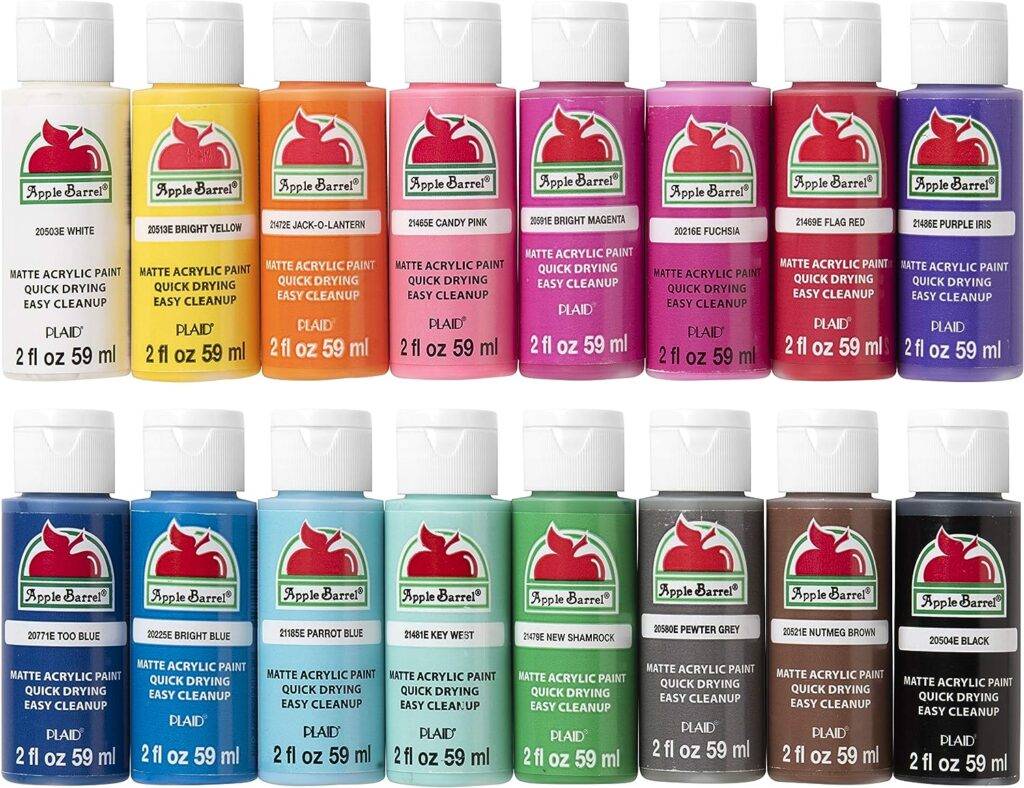
Apple Barrel Acrylic Paint Set is a versatile acrylic paint set includes 16 – 2 oz bottles of colorful craft paint. The colors in this kit include: White, Black, Flag Red, Jack-o-Lantern, Bright Blue, Candy Pink, Nutmeg Brown, Bright Yellow, New Shamrock, Purple Iris, Too Blue, Fuchsia, Key West, Pewter Grey, Bright Magenta, and Parrot Blue as well.
Each of these bold and bright colors dries to a brilliant matte finish – perfect for all your arts and crafts! Use on a variety of surfaces including wood, Styrofoam, plaster, terra cotta, and more. This versatile acrylic paint can easily be brushed, stamped, stenciled or sponged to your projects
Clean up is easy with Apple Barrel acrylic paint. Simply clean up while wet with soap and water. Great acrylic paint set for adults and kids!
DecoArt Americana Acrylic Paint Value Pack
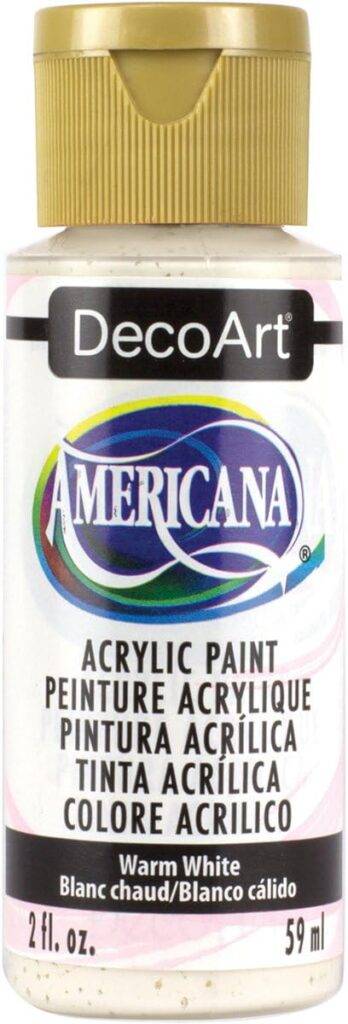
DecoArt Americana Acrylic Paint set of 12 basic colors is a bit more expensive, but it comes from the DecorArt brand. Paints from this well-known brand always provide a smooth, rich finish that works well on many surfaces, as well as fabrics! They have rich, pigmented colors & a thicker finish.
Cadmium yellow, ebony black, and true blue are included in the starter set. Multiple surfaces are guaranteed to work with these paints, although the manufacturer recommends mixing in the appropriate medium when applying to glass and fabric.
FolkArt Multi-Surface Paint In Assorted Colors

Are you looking for a particular color of paint? Take a look at these 2 oz bottles from FolkArt Multi-Surface Paint In Assorted Colors. A leading brand of craft paint, you can trust the quality of each color.
You can opt for another finish, but this satin finish offers excellent coverage that is highly pigmented. Moreover, you can select from a wide variety of fun colors such as Moon Yellow, Wicker White, and Persian Blue!
Jacquard Textile 8 Color Set

With the Jacquard fabric paint set, you can paint both natural and synthetic fabrics. The liquid fabric paint, even after washing and drying repeatedly, will not chip, crack, or peel. Since it’s highly pigmented, it can be used straight from the bottle, but if you’re looking for a thinner consistency, water can also be used.
Jacquard Textile 8 Color Set can be used in a variety of ways, based on its thickness. Along with the 3 core colors and 3 secondary colors, there is a sufficient amount of black & white in this package. As a result, it is possible to mix these pigments to create new color combinations. Your options include block-printing, stamping, stenciling, and even airbrushing, according to your needs.
Arteza Fabric Paint, 30 Colors

Arteza’s permanent acrylic paint is suitable for a variety of surfaces, from soft T-shirts to rough denim, available in 30 colors. In addition, the bundle contains vibrant colors, fluorescent shades, metallic tones, glow-in-the-dark, and glitter acrylic paint. Experimenting with them, we discovered they mixed easily and created new hues & textures.
Even after repeated washing and dryings, these acrylic-based paints will not crack and peel. In contrast, most of their competitors cannot withstand regular washing and dryer drying. Arteza fabric paint dries quickly and safely after being ironed, resulting in permanent effects. According to ASTM D-4236 and EN71 guidelines, AP Certification assures that this paint is safe for textiles.
Tulip 17581 Glow in Dark Fabric Paint
[amazon box=”B005E0CD0G” description=”none”]Tulip 17581 Glow in Dark Fabric Paint is machine washable and non toxic, use these 6 fabric acrylic paints from Tulip. Their brightness isn’t an issue either. Many customers comment that they glow very brightly in black light and give it a high rating. However, to achieve the best results, allow them to dry & then let them ‘charge’ under bright light for approximately 15 minutes.
Colors do not glow equally, with white, green, and blue being the brightest. If your child wears a denim jacket at night, you might want to add a dash.
Sharpie Stained Fabric Markers, Brush Tip
[amazon box=”B004O6M8Z6″ description=”none”]Sharpie Stained Fabric Markers brightly colored ink designed to help you customize shirts, backpacks and more. It’s smooth brush tip lays down both thick and thin lines and perfect for hand lettering and calligraphy as well. Basically, Sharpie Stained Fabric Markers can be used to create T-shirts professionally, as a hobby, or just for fun with the kids. It adheres to a wide array of different types of fabric. During normal washing cycles, the ink does not fade.
However, T-shirt creative projects benefit from their quick drying times, smear-proof properties, & water resistance. Its fine tips allow for sharp lines, and its nontoxic ink lets you draw without worry. Luckily, it has Black, Blue, Green, Yellow, Orange, Red, Pink and Purple fabric markers in one packet.
Acrylic Paint Vs Fabric Paint: Comparison Table
In the world of artistic expression, choosing the right paint can make or break the final outcome of your project. Two popular choices are acrylic and fabric paint, each boasting a unique set of characteristics, applications, and results.
| Acrylic Paint | Fabric Paint | |
| Features: | Composition: Water-based, quick-drying. Texture & Finish: Can be thick or thin, glossy, matte, or satin finish. Color Mixing: Mixes well, offering a wide range of colors. Adherence: Bonds to many surfaces. | Composition: Specifically designed for fabrics, often water-based. Texture & Finish: Soft and flexible, maintaining fabric’s feel. Color Mixing: Offers vibrant colors that stay true after washing. Adherence: Binds excellently to fabric surfaces. |
| Made Items: | Art canvases Craft projects Home decor Wood furniture | T-shirts & clothing Textile banners Upholstery & curtains Decorative fabric items |
| Quality: | Durability: Highly durable, may crack on fabric over time. Fade Resistance: Resistant to fading, but not as effective as fabric paint on textiles. | Durability: Stays soft and flexible, won’t crack or peel. Fade Resistance: Highly resistant to fading when washed. |
| Application: | Tools: Brushes, rollers, sprayers. Technique: Easy to apply, can be diluted with water or mediums. Drying Time: Quick drying. | Tools: Brushes, stamps, stencils, sponges. Technique: Requires heat setting for permanence. Drying Time: Varies; heat setting accelerates the process. |
| Pros & Cons: | Pros: 1. Versatile; adheres to multiple surfaces. 2. Wide color availability & mix-ability. 3. Durable & resistant to elements. Cons: 1. Can become stiff & crack on fabrics. 2. May require fabric mediums to improve flexibility. | Pros: 1. Designed for fabric, remains soft & flexible. 2. Washable & fade-resistant. 3. Easy to use for beginners. Cons: 1. Limited to fabric materials. 2. May require multiple coats for opacity. |
Finally, while both acrylic and fabric paints have their own unique merits, choosing between the two boils down to the nature of your project. For diverse surfaces beyond fabric and a broad color spectrum, acrylic paint is your go-to. However, if you’re focused on textile projects and desire a soft, washable finish, fabric paint is the unmatched option.
Some Most Asked Question From “Quora”
How can I get acrylic paint to stay on clothes even after a wash?
Acrylic paint will normally stay on cloth even through quite a number of washings. At least, 100% acrylic will. Of course it helps if it is soaked into the fiber rather than just laying on top, like it would with just a light spray job. I use regular artist acrylics for work on fabric and I haven’t had any problems yet.
“Laurie Brown”
How can I get acrylic paint to not wash off my shirt?
Acrylic paint will normally stay on cloth even through quite a number of washings. At least, 100% acrylic will. Of course it helps if it is soaked into the fiber rather than just laying on top, like it would with just a light spray job. I use regular artist acrylics for work on fabric and I haven’t had any problems yet.
“Nikki Bar”
I’ve painted on a few hats with acrylic paint. What can I put on the hat to ensure the paint is permanent before I sell them?
At this point it’s likely too late. If the hats are fabric, you should have added fabric/textile medium directly to the paint as you painted. That’s what’s used for painting t-shirts and other fabrics – that medium works very well to increase the life of the paint on fabric.But just so you know, acrylic paint is essentially liquid plastic, so adding to any surface on objects that will be in use, especially on an object that will be in regular use, it will not be perceived as permanent, it can crack, chip and weather over time.You could add a polymer medium coating over the paint that would help protect the paint. Golden Acrylics has a good polymer medium that’s not as much a hard finish as a varnish.You could also mask off the unpainted area and give a light coat or two with a spray varnish that would provide some protection.
“K Grace-deLily”
I painted a jean jacket with plain acrylic paint, I didn’t mix it with anything. It’s not that I regret doing it, I just would like to change the design. If I washed it, would it come off? If not, how could I?
First, wash it in hot hot water. Some acrylics will soften and turn into like slime or a sticker which you can pull off while it’s wet and warm still. Try that.Then, whatever doesn’t come off that way will come off with Goof Off, a latex paint remover. It smells like thinner or acetone but it does the job. You’ll need a bunch of it. Wash your jacket afterward if you don’t want to smell like a diesel mechanic.
“Jay Beardsley”
How do I wash a shirt that has acrylic paint on it without removing the paint?
Depending on the durability of the acrylic paint, the shirt should be able to withstand washing. However, the best approach is to gently HAND WASH the shirt in Woolite or another gentle detergent, and then drip dry. Keep in mind that this is wearable artwork, and tossing it in with the jeans and other garments are going to cause it to fade much faster.
“Michael Townsend”
How can I set the acrylic paint my daughter used on a t-shirt so it won’t wash off?
Usually adding textile medium to the acrylic paint while you are painting helps with this. I think maybe it makes the paint a bit more flexible?However…. After paint has dried on fabric it will stay very well even without any fixative. My work clothes are all covered in paint. I wash them regularly even if I do look like I need a shopping trolley for my worldly possessions.
“Luce Mayhem”
Can I Use Vinegar & Acrylic Paint Together?

YES, you can. It is possible to make your own fabric medium if you don’t have one. You can do this with household ingredients such as vinegar and glycerin. To dye fabric traditionally, vinegar was used as a mordant.
Glycerine and water are needed in equal parts to prepare vinegar for acrylic paint. Basically, it works the same as oil paint. To make the acrylic paint your preferred consistency, you can pour the liquid into it.
In order to create an ink-like quality, vinegar is an ideal homemade medium. It can be used to stamp paint on working projects such as:
- Clothing
- Bags
- Hats
Can Acrylic Paint Be Washed Off Clothes?

Acrylic paint washes off clothes & surfaces when wet, but becomes permanent after drying. It is pretty tricky to remove acrylic paint from fabric once it has dried. However, to ensure the art will last a long time, some extra precautions must be taken, such as sealing or heat setting.
Further, if your textile art is properly cared for and cleaned, it will last even longer. It is recommended not to wash an item that has just been painted for 4 days at least. That will allow the paint a chance to dry properly and adheres.
If you can’t wash the item by hand, wash it on the delicate cycle in the washing machine & tumble dry it on low heat. You should iron it on the reverse side using low heat, beginning with the painted side.
A tip to remember, textile mediums are another way to ensure your fabric art will last. Acrylic paint is softened this way, making it durable and capable of withstanding multiple pieces of washing.
Also, acrylic paints usually dry permanently, but there are washable acrylic paints available. Check the label carefully before you buy.
Before Painting, Does The Fabric Need To Be Prepped?

It is necessary to prepare the fabric surface before painting with acrylics. It is an affordable and straightforward process. For this project, acrylic paint and fabric medium will be needed.
- The fabric should be washed first. A washing cycle keeps the fabric’s original shape.
- You shouldn’t be concerned about it shrinking or stretching afterward and damaging the finish after subsequent washings.
- The cleaning process also removes debris, dust, and other substances that might interfere with a paint’s adhesion to the fabric.
- The fabric should also be ironed. Fabric that is wrinkled makes painting difficult, which is why an iron helps soften and manage the fabric.
- Next, prepare the material with sandpaper or mix acrylic paint with fabric medium.
- When painting shirts, placing cardboard inside will prevent unwanted paint from bleeding through.
How Can You Use Acrylic Paint On Denim? [Top 10 Tips]

Denim can be decorated with acrylic paint in countless interesting ways! The possibilities are endless. If you wear jeans, you can attach realistic portraits or stamp emojis onto a backpack.
You can walk through these general steps to paint on denim:
- First, make sure your denim is clean and dry. The boring steps of pre painting may seem tempting, but don’t do it! This will prevent your painted pattern from stretching and skewing later on.
- If you wish, you can outline your design with a pencil and fabric marker. This preliminary marking will be covered by thick acrylic paint later.
- Decide on your colors, but you shouldn’t prepare your palette till you are ready to paint. Considering how fast acrylic dries, you don’t desire the colors to dry out too early.
- Add fabric medium according to the package instructions. Straight acrylic paint can be used on denim, but this should not be done on a wearable item. If you wash denim without using a medium, the paint may crack & peel off.
- There are dozens of ways to apply paint. If using a paintbrush for freehand work, natural hair brushes will work best on acrylic paint.
- Wait until the paint is completely dry before moving on to the next step. At least 24 hours should pass before attempting the next step.
- Then, seal the paint with a light fabric medium topcoat or set it on heat.
- For heat-setting, you should turn the fabric inside out so that the painted design can be ironed on. Spread a pressing cloth on the area where you will be ironing. Use a medium-hot iron to press the pressing material slowly.
- Be careful. Do not wash your garment in a delicate setting until it has sat for at least 4 days.
- Finally, you can enjoy your wonderful newly decorated denim.
If you are painting denim with acrylic paint pens or acrylic paint, you can seal the paint with regular Mod Podge or special fabric Mod Podge.
Is Acrylic Paint Safe To Use On Fabric Shoes?

Fabric shoes can be painted with acrylic paint. White, stained shoes can be transformed into beautiful works of art with this process! It’s an easy expression of your personality.
Although acrylics may not work on leather or plastic shoes, this method can be used on fabric shoes.
You can paint shoes with acrylics by following these tips:
- Before applying any paint to your shoes, make sure they are clean & completely dry.
- Paint should not be applied to the soles of your shoes, so tape them off. Just like when you paint a wall, make sure to tape off the baseboards & ceiling to prevent smudges!
- Stay away from newspapers when you’re painting. Newspapers could mark your shoes with paint. Make use of cheap plastic tablecloths or cardboard instead.
- Because acrylic paint dries quickly, using short and repeated strokes is best for getting an even coating of paint.
- To create unique styles, you can even use sponges or airbrushes!
- To ensure that your shoes are thoroughly dry, let them sit for 2 days before using them.
- Finally, you may need to use a clear sealant in this case! A clear, thin layer of paint can be brushed on or sprayed on with a spray paint version.
How To Paint Fabric With Acrylic
Once your paint is ready, let’s move onto the most exciting part: Painting!
Below is a quick guide to help you get started:
1. Pick Your Fabric
- As we are working with acrylic paint and a fabric medium, it doesn’t matter whether the fibers are synthetic or natural.
- It is recommended that you consider its color & texture.
- You should choose something plain so that your colors can pop, avoiding rough textures that might complicate the painting process.
2. Select Your Design
- For this project, we recommend looking at a reference photo, or even better, practicing on a different surface before starting.
- Always remember, stains will persist forever once you paint something there.
- Thus, you should avoid making mistakes whenever possible.
3. Plan Your Design
- If you’ve already chosen the image you’d like to paint, sketch an outline of it with chalk on your fabric.
- By doing so, you can capable to erase it & edit it easily if necessary.
4. Create Your layers
- The beginning of painting is right here. Creating the background is the first step, then layering the colors until the desired image is achieved.
- Darker and chunkier parts should be painted first, followed by highlights and details.
- That’s great! Now that you have completed your 1st fabric drawing project. However, how about making a patterned fabric?
Finally, does each element need to be painted by hand? In short, “NO”, you don’t. Alternatively, you can create a pattern.
Acrylic Paint: How To Create Patterned Fabric
As a guide to creating patterned fabrics with acrylic paint, the following steps are recommended:
Materials Needed
- Printing block (preferably wood)
- Fabric
- Acrylic paint
- Fabric medium mixture
- Clean sponge
- Brush
Procedure For Self-Coloring
- You can follow the 1st step of the previous guide.
- However, the design does not need to be decided yet since the printing block has already been created.
- You should, however, use chalk to mark the spots where you wish to apply the stamp.
- In order to create a more uniform look, you can measure the distance among the elements with a ruler.
- Our next step is to begin stamping once we’ve decided which stamp to use.
- First, paint the sponge with a clean brush. The ink pad will be used for this purpose.
- A test stamp should be performed on a separate surface after pressing the printing block onto it.
- If you desire your design to appear solid, your colors need to be distributed evenly over the block.
- To ensure this, you should brush your “ink pad” thoroughly, covering the area that will be touched by your stamp.
- In this case, it’s simply a matter of stamping away.
Tips For Using Acrylic Paint On Fabric
In order to achieve the best results, consider the following tips before painting or stamping your fabric with acrylic paint:
1. First, Wash Your Fabric
- By washing your fabric first, you can ensure it won’t shrink suddenly after initial washing, something that sometimes occurs.
- In addition, this will prevent any dust or particles from adhering to wet paint when it dries.
2. Iron The Cloth
- When you iron your fabric, it will be much easier to paint on because its surface will be smoother & more manageable.
- Obviously, you shouldn’t paint over wrinkled fabric because you can’t achieve the desired design.
- Effort, time, and materials will all be wasted if you start dye with wrinkled fabric.
3. If Possible, Test The Paint First
- Would you mind getting a small swatch of the material that you intend to paint on? Wonderful!
- You can try your paint & medium mixture on it to see if it works as expected. You can use Badger Air-Brush-Paint Mixer for the best result.
4. Dry Your Work Entirely Before Washing
- Unlike “oil paints”, acrylic paints are water-based, so they can easily be removed with water when they are still wet.
- Despite being convenient for removing splatters off of your favorite outfit, any project you work on shouldn’t be affected.
Pro Tip: To make your work last longer, heat-set it. Using “Liquitex Fabric Medium” will give you a soft, stretchy result. In addition, you can thin your paint with distilled water, but make sure not to thin it too much.
Heat Settings: Let’s Discuss
In this case, the question arises, what is heat setting, & how can heat settings be applied?
- During heat setting, heat is applied directly to the textile’s fibers to ensure that they are properly absorbed by the fabric paint.
- As a protective finish, it can be treated as a sealing method.
- The process is very simple. With a pressing cloth and a dry iron, you can do this easily.
- It is first necessary to press the pressing cloth over the painted design once it has been completely dried.
- Next, using your “dry iron”, press on top for a few seconds, and you’re finished.
- You should ensure that the entire painted area is heat set for safety.
Post-Painting Fabric Care Tips
Make sure you don’t think that heat setting your project will protect it from natural wear & tear.
For long-lasting care of your painted fabrics, follow these tips:
1. Reducing Its Washing Time
- There can be challenges in extending the integrity of wearable art. However, this step is crucial to ensuring your finished piece is sincere.
- Ultimately, washing your clothes stretches it and rubs the fibers together, causing the paint to slowly peel off over time.
2. Gently Wash It
- Whenever you want to clean your project, wash it on the gentle cycle in the washing machine, or even better, hand wash it.
- Through this method, the painted area can be handled with the least amount of effort.
3. Hang Fabric To Dry
- Regardless of how low the setting is, never put your piece in the dryer. Instead, you should hang it outside to dry.
- Using this method, painted surfaces will be spared even more pressure when necessary.
Finally, with the tips we’ve provided in mind, your dyeing project will last longer for years to come!
Best Alternatives To Acrylics For Painting Fabric

Fabric Paint
Fabric may not be suitable for acrylic painting, since it requires additional steps. It is advisable to simply buy fabric paints that have already been formulated with fabric medium as an alternative to acrylic paint. It is designed for easy attachment to stretchable materials; fabric paints are flexible.
Fabric paints come in a variety of colors and are specifically designed for fabrics.
Spray Paint
Another great acrylic paint alternative is spray paint. Most often, it is used to paint furniture, brick, metals, and various tough materials. This can also be used to create cool patterns & designs for clothing and textiles.
Graffiti can be effectively created using spray paint, fabric paint, and acrylic paint.
Fabric Dye
Fabric dye is the final alternative besides acrylic paint. You can dye fabric to create tie-dye patterns, or just to make a white shirt a different color. As far as we’ve discussed so far, fabric dye can be combined with any paint we’ve discussed so far. As an example, create a dark effect by dyeing the fabric purple or black, followed by a layer of acrylic paint or fabric paint.
FAQs About Acrylic Paint On Fabric
How To Soften Fabric After Painting?
After painting with regular acrylics, the fabric may feel stiff. Alternatively, you could use fabric paint or gouache, which would have a different look. If you don’t want to use rough materials, you can mix acrylic paint with a textile medium.
For mixing acrylic paint and textile medium, prepare them as described above. Fabric mediums generally require 1 part acrylic paint to 2 parts textile medium. The mixture should be thoroughly mixed. Additionally, ironing the paints sets them and helps soften them.
What Type Of Fabric Works Best With Acrylic Paint?
Acrylic paint works best with natural fibers, especially cotton, silk, or linen. Tighter weaves and more absorbent fabrics are better for painting, ensuring better adhesion and durability. Do not use synthetic textiles, such as nylon or polyester, since they lack absorbency and can peel or crack paint in time.
Acrylic Paint Can Be Used On Dark-Colored Fabrics?
Obviously YES. Acrylic paint can be used on dark fabrics, but you might have to apply white or lighter color base coat first. Fabric medium is also important for acrylic paint to adhere properly to fabrics so that it won’t crack or discolor.
Can Acrylic Paint Be Made Permanent On Fabric?
Heat-setting acrylic paint makes it permanent on fabric. When the paint is dry, iron the painted portion on a high heat setting for 5-10 minutes. By doing this, the paint will be set and will resist washing & fading. A fabric medium can also be added to paint prior to application, enhancing its flexibility and durability.
Can I Heat Dry the Paint?
It is possible to heat dry acrylic paint in a similar way to the heat setting. However, you must let the paint dry for a minimum of 24 hours before ironing it. Make sure the surface is evenly dried by using a hairdryer on low heat.
Can You Spray Acrylic Paint On Fabric?
Yes, you can. We did it exactly like that here. By applying acrylic paint dried soft like the fabric because I added a medium. As a result of the glycerin medium, the product was thinned and could easily pass through the spray bottle’s small tube.
How Long Does Acrylic Paint Last On Fabric?
It is possible for acrylic paint to remain durable on fabric. When acrylic paint is applied to the fabric, it becomes permanent, effectively sealing the acrylic within. Furthermore, acrylic paint can easily be removed from clothing if you act quickly by washing it with soap and warm water.
Without A Medium, Can Acrylic Paint Be Used On Fabric?
Sure, acrylic paint can be used on fabric without applying a medium. Whenever you paint on a fabric you want to wear frequently, such as a t-shirt, use a medium. In the absence of a medium, painting thins the fabric medium, which makes the fabric stiff and unattractive to wear. When painting fabric, you don’t need to worry about the texture as much and would prefer a thick texture.
Can Acrylic Paint Be Washed?
Yes, it can. Acrylic paint can be washed off, but only while it is still wet. Paint will be extremely difficult to wash off once it has dried. Usually, within 20 to 30 minutes or more time passes, it becomes harder. If it has already been treated, there is no turning back.
Does Acrylic Paint Need To Be Sealed On Fabric?
For acrylic paint to be sealed on fabric, you should use a fabric medium sealer. Alternatively, you can use acrylic fabric paint and the textile medium as well!
As A Final Word
Can you use acrylic paint on fabric or not? In itself, NO. Experts do not recommend it. But with a fabric medium? YES, definitely.
Glycerine and vinegar can be used to make fabric mediums or you can purchase one. Once it has dried, acrylic paint will become more pliable. Instead, you can stamp the design onto your fabric with a printing block, using your paint on a sponge and applying it like ink.
Finally, heat setting will extend your work’s life, but nothing beats care and maintenance to keep it looking beautiful! However, what has been your experience with acrylics on fabric? Have you done any projects with them? Do you have any tips to share with us? If so, then let us know by commenting below.
